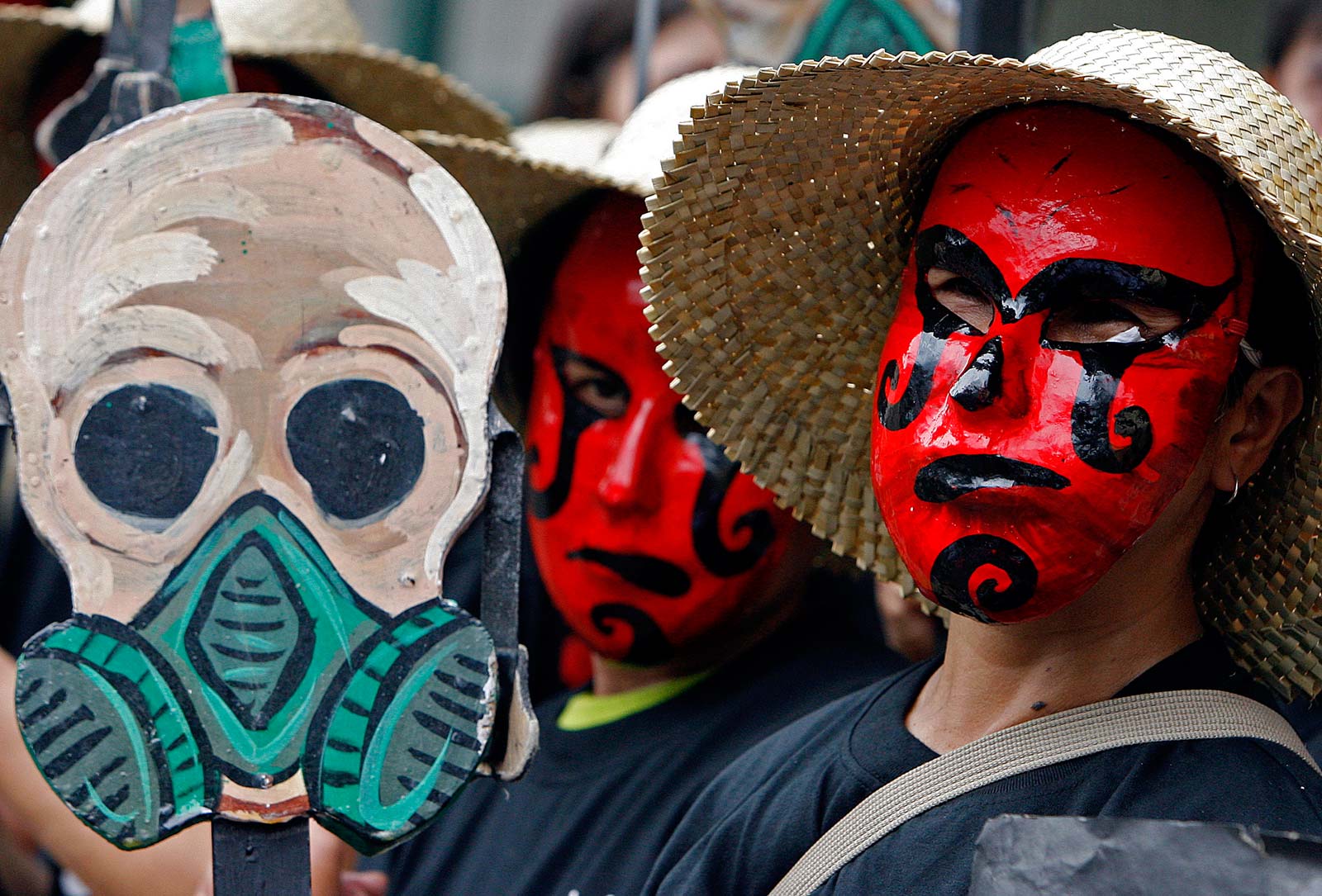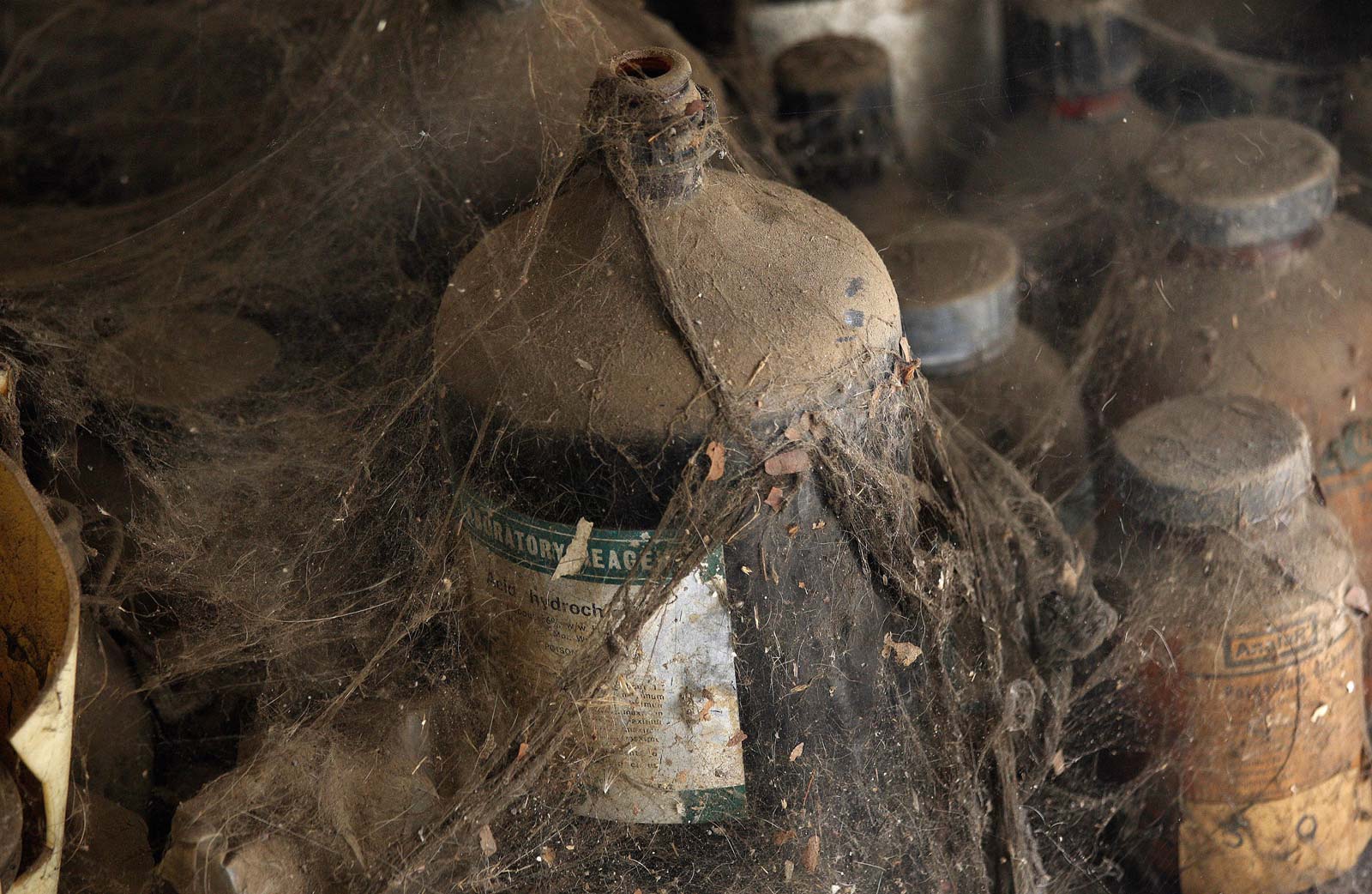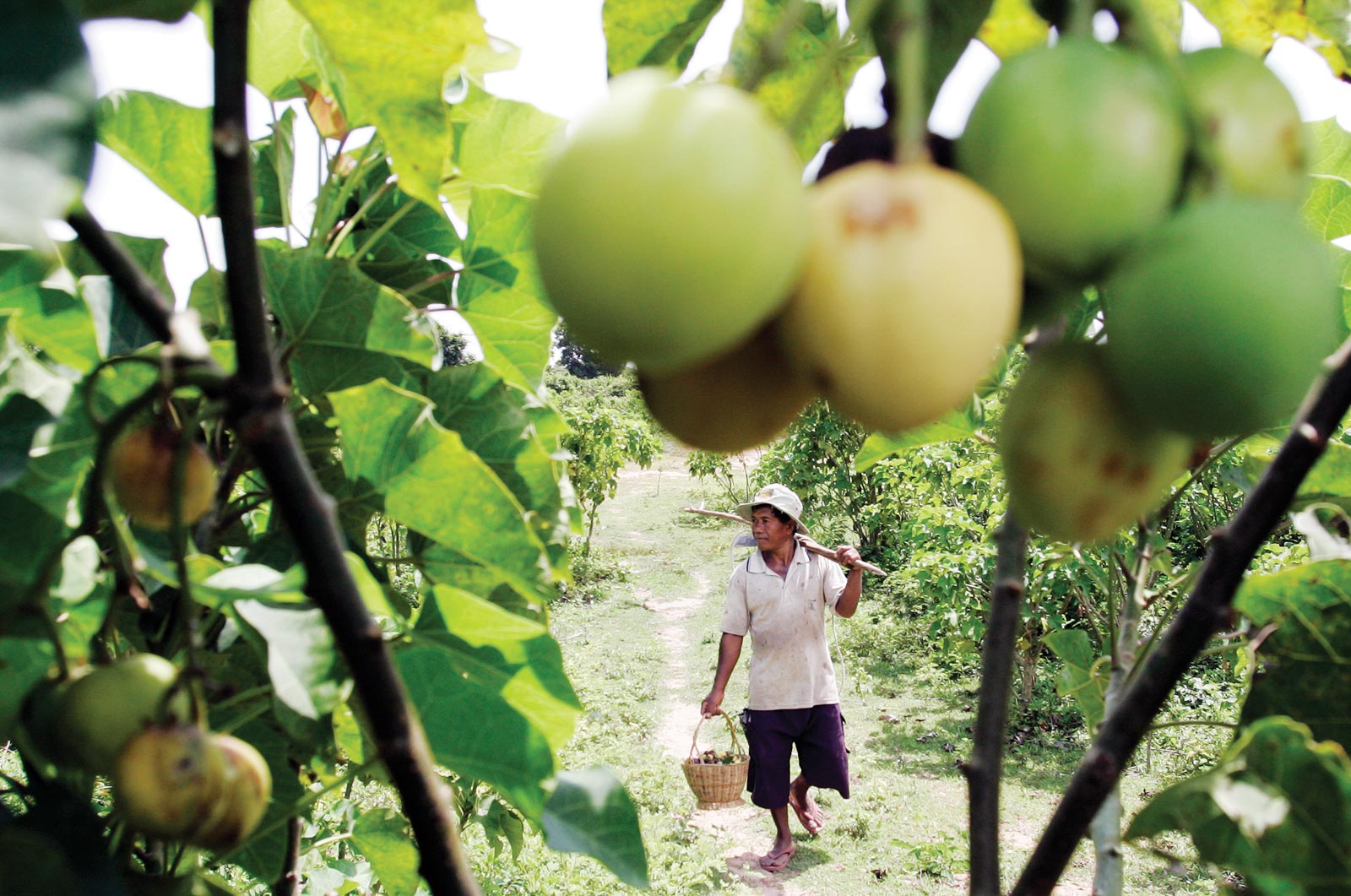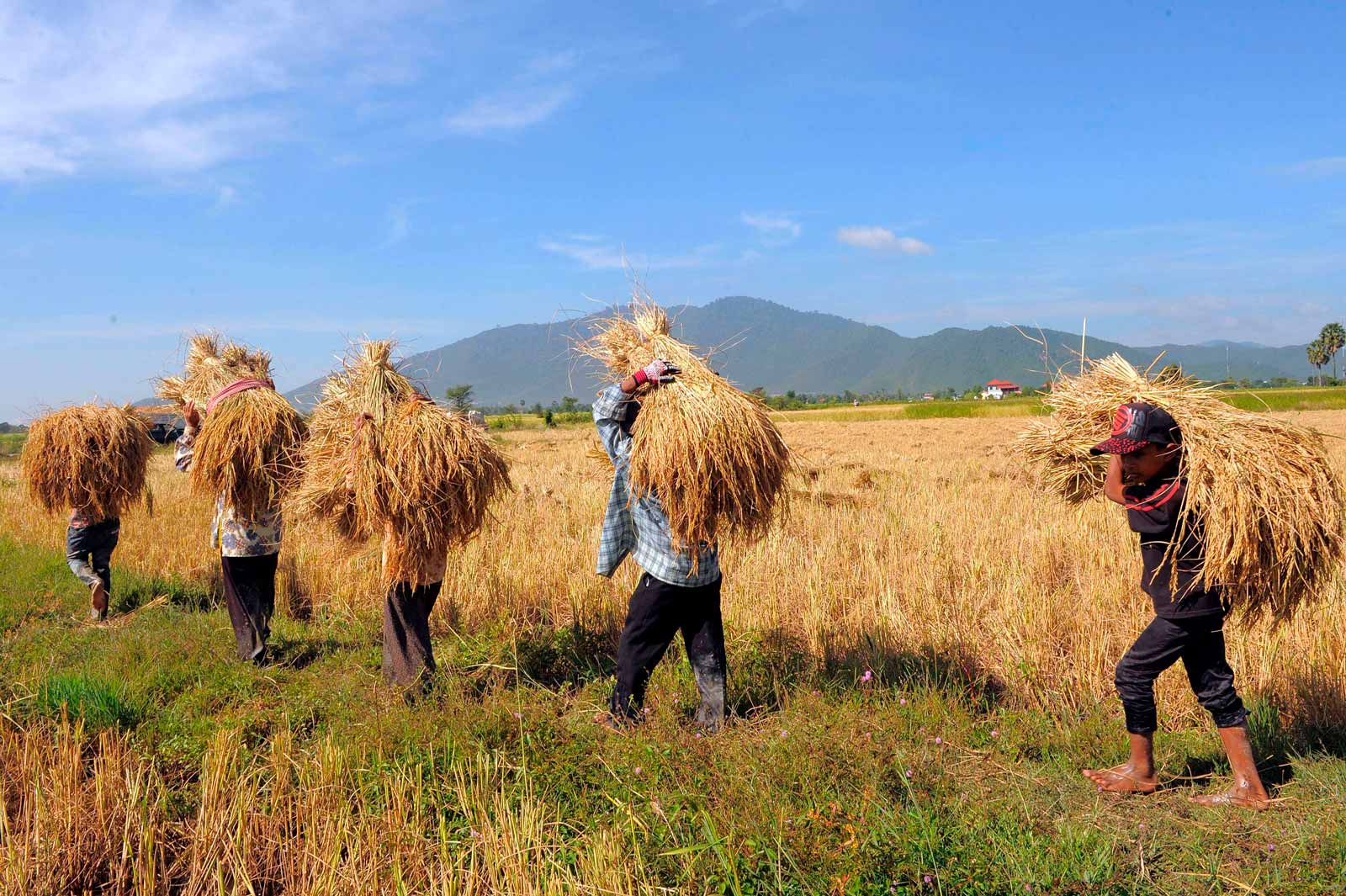Shaking hands, lingering rashes, breath catching in your chest.
A sense of fatigue, sluggish reflexes and – if you’re really unlucky – cancers spreading through your lymph nodes, breasts and blood.
All of these are symptoms of chronic pesticide poisoning, a little-studied condition in Cambodia and much of Southeast Asia. It doesn’t just affect the farmers and their hired hands, the men and women who spray rice and vegetables alike with chemicals formulated to kill weeds, bugs and fungi. When misapplied to crops, as is often the case in the region, pesticides enter the food chain through contaminated water and market goods.
Despite official attempts to limit the use of harmful pesticides, Yang Saing Koma, a long-time agricultural leader in Cambodia, has seen little evidence that things are getting better. Nor has there been a concerted effort to study the wider impact of agricultural chemicals on consumers and ecosystems.
Filipino environmental activists wear masks during a demonstration outside the Department of Environment and Natural Resources (DENR) office in Quezon City, eastern Manila, Philippines. Environmental groups are pushing for a ban on aerial spraying of agrochemicals in banana plantation farms in Mindanao, southern Philippines, due to the side effects posed by pesticide contamination in the air, the groups claim. Photo: Alanah M Torralba/EPA

“I don’t think our medical field has the capacity for it,” Saing Koma said, shaking his head in a Phnom Penh restaurant supplied with vegetables from growers affiliated with the Cambodian Center for Study and Development in Agriculture (CEDAC), the farm advocacy group he founded in 1997. “There are so many cases, and so many who will tell you their story.”
Saing Koma left CEDAC in 2016 for the political realm, a stint that included a 2018 run for prime minister at the head of his Grassroots Democratic Party. Though he still works with farmers as part of his commune-level organising, he said that his exit from the agricultural group roughly aligned with its own transition away from documenting pesticide poisonings to teaching organic farming methods. The move left yet another gap in a vital data-gathering process in the Kingdom that has long relied on NGOs and foreign researchers.
A representative from the Cambodian Ministry of Environment said the issue was one that would be handled by the Ministry of Agriculture, Forestry and Fisheries (MAFF), but was unsure who there would be responsible for it. A request for information made to the MAFF went unanswered.
Much of the data we do have has come from outside sources. In 2011, a Danish survey of 89 smallholder farmers around Boeung Cheung Ek Lake, an agrarian community near Cambodia’s infamous Killing Fields genocide memorial, found that nearly nine out of ten farmers had experienced acute pesticide poisoning from chemicals they used in the field.

Chemical waste in seen at the Union Carbide plant in Indian city of Bhopal, Madhya Pradesh. On 03 December 1984, some 3,800 people died instantly, many of them in their sleep, when around 40 tons of highly poisonous methyl isocyanate gas leaked out of a pesticide-producing unit at the Union Carbide plant. Photo: Harish Tyagi/EPA
Even though farmers told researchers they had taken routine precautions, such as washing their hands and showering after applying the formula, the combination of powerful and often illegal chemicals as well as a lack of knowledge about safe use led to the widespread poisoning of the men and women who grow water spinach at the lakeside.
“They don’t know how to protect themselves, and even if they do they might not have the funds to buy protective gear”
Ule Johansson, Swedish Chemicals Agency
Farmers reported nausea, dizziness, rashes and difficulty breathing. Moreover, the study showed that half of the pesticides used by growers were among those categorised by the World Health Organization as either “highly” or “extremely hazardous” to humans.
The Danish report covered metropolitan Phnom Penh, but a wider survey would likely turn up similar findings outside of the capital. From what agricultural educator Bunika San has seen, some of the worst misuse of agricultural chemicals happens along the Cambodia-Vietnam border, where Khmer farmers are using powerful herbicides imported from the neighbouring country, unable to read the Vietnamese-language labels.
Staggering numbers
Such pesticide problems are not unique to Cambodia. Reckless or untrained chemical use hurts farmers across the developing world – with a 2017 United Nations report estimating that pesticides could cause 200,000 acute poisoning deaths each year.
“The overwhelming number of fatalities, some 99%, occurred in developing countries where health, safety and environmental regulations were weaker,” the report said.
Other estimates of the number of deaths are higher yet – and they’re not all accidents. Mounting evidence shows that pesticides are a major method of suicide around the world. Through the early 2000s, self-poisoning with these chemicals may have represented more than one-third of all suicide deaths around the world, as well as the leading cause of completed suicides in certain Asian countries.
Ule Johansson of the Swedish Chemicals Agency, or KEMI, describes the numbers as “staggering.”
Based in Stockholm, KEMI is a state authority that recently concluded a decade-long governance project in Southeast Asia. That initiative focused on Cambodia, Laos, Myanmar, Thailand and Vietnam, with the aim of strengthening policies that protect agricultural workers and consumers in those countries.
Having wrapped up that work with admittedly limited results, Johansson pointed to the widespread acute poisonings as a symptom of a systemic lack of resources, knowledge and oversight both in farm fields and government offices.
KEMI representatives, he explained, found that local regulatory systems were unfunded and understaffed and that farmers and industry officials had little incentive to reform how they used pesticides.
For smallholder farmers who work alone, even minor changes might not be feasible.
“They don’t know how to protect themselves, and even if they do they might not have the funds to buy protective gear,” Johansson said of farmers in the countries KEMI worked in for their most recent project. “There’s no-one dying, or very few people, dying from pesticide use, acutely, in the developed countries.”
Most nations regulate agricultural chemical use, Cambodia included. But as with many laws in the country, enforcement is lax in Cambodia, which – as is the case with many developing economies – is aiming to increase agricultural production.
Bunika, who heads Agri-Smart, a Phnom Penh-based social enterprise and agricultural engineering firm, has spent much of his career teaching farmers how to use chemicals safely and effectively. But for those he works with, the bottom line is often all that matters.
“When they’re planting the rice, they’re talking about money, not of eating it,” he said. “Before, we were talking of feeding their family, and that was all of Cambodia.”
He added that farmers are usually aware of the short-term risks of using the chemicals but choose to gamble their health for what they believe to be a better chance of higher yields and greater profits.
“They see it, they know it, but they’re still doing it.”

Compound injuries
Despite their human toll, pesticides remain an integral aspect of global agriculture. They include compounds used to kill unwanted organisms in the field and are broadly divided between insecticides, herbicides and fungicides. Though modern pesticides are designed to minimise hazards when used as specified by the manufacturer, they can still pose a threat to the health of farmers, their neighbours and the environment.
The risks associated with pesticides add to the sense of urgency among those who promote safer use techniques – such as spraying methods that limit the number of unnecessary applications to crops and avoid bodily contact with chemicals – as well as procedures for clean-up and dealing with accidental exposure.
It can, however, be difficult to get the right information to low-income farmers, many of whom were mostly subsistence farmers until recently. If chemical containers are labelled at all, the pesticides used in Cambodia are usually imported from Vietnam or Thailand and are plastered with information written in the languages of those countries. And even if labelled in Khmer, the containers often come without user instructions and lack clear or thorough warnings.
“These labourers make very low wages and they’re often not informed of the effects of pesticides on their health”
Deeppa Ravindran, PAN Asia Pacific
For farmers in rural Cambodia, some of whom may be illiterate in Khmer or their local tongue – much less a foreign language – this information is useless. Farmers therefore are more likely to follow whatever advice they hear from shopkeepers or peers.
Regional and local groups like Bunika’s have stepped up in fields hundreds of miles apart to fill some of the gaps in state systems meant to protect agricultural workers. These organisations include environment and health researchers from universities, NGOs in various fields and local grassroots organisations that focus on farm education and training.
The Pesticide Action Network (PAN) is an international advocacy organisation that researches the health effects of the chemicals and presses governments to more stringently control their use. The Malaysia-based Asia Pacific branch of PAN regularly publishes reports on the health impacts of pesticides, covering a region spanning from the Philippines to Pakistan.
PAN Asia Pacific representative Deeppa Ravindran sees weak or nonexistent enforcement measures as the source of harmful practices. On larger farms and plantations, she said, problems with chemicals may also be part of a wider set of exploitative labour practices, particularly on oil palm plantations in Malaysia and Indonesia
“These labourers make very low wages and they’re often not informed of the effects of pesticides on their health, not the short nor long-term consequences of using these pesticides,” she said. “There’s also not enough [protective equipment] for them, or it’s just too hot to actually use it.”
Ravindran said most of the plantation labourers her group interviewed avoided revealing their identities for fear of retribution by employers. Many are migrant workers from Bangladesh, Nepal or other Asian countries, a complicating factor that introduces additional language barriers to chemical training – as well as possible avenues for abuse.
Malaysia hosts an estimated 6.2 million migrant workers, many of them vulnerable to exploitation as employers confiscate passports and ensnare workers – many of them arriving in the country illegally and vulnerable to police raids and deportation – in debt traps via under-the-table “recruitment fees”.
Johansson, who visited some plantations in Malaysia with assistance from PAN Asia Pacific, let out a dark chuckle as he said there were “quite a lot of indications that sprayers in plantations do not have an easy life”.
“They spray every day, seven days a week, probably year-round,” he said. “They’re happy for the work and the money but in our view, we think they’re very exposed and how their health will be in the long-term – I don’t know if I want to know.”
Still, he said, getting information from smallholders is a far sight easier than investigating the relatively closed-off world of industrial agribusiness.
Researchers know that some of the pesticides that workers spray in plantations – such as the herbicide paraquat, which will be officially banned in Malaysia starting next year – can cause severe acute reactions, including vomiting, seizures and an inability to breathe.
Organisations such as the US Environmental Protection Agency (EPA) suggest that though linking disease to pesticide use is usually less clear-cut compared with immediate and direct cases of pesticide poisoning, a growing body of research from the EPA and others suggests a connection between exposure to pesticides and cancers such as non-Hodgkins lymphoma.
Attempts from governments to track these rates gives us some baselines that point to a broad problem for agricultural workers. A 2018 PAN Asia Pacific report that cited Vietnamese research estimated 1 million farmers in that country could have chronic pesticide poisoning.
If chronic poisoning effects are tough to pinpoint in farmers, they can look even more complicated when studying the wider population outside of agriculture. For the usual tragic reasons, short-term effects are far easier to record.

Vietnamese investigators eyed pesticide residues on produce as the main culprit in a 2002 wave of food poisonings that killed more than 270 people and made around 7,650 more people sick. Last year, three people died from poisonings in the Chetr Borie district of Cambodia’s Kratie province, with toxic pesticides and chemical fertilisers later found polluting the area’s streams and rivers. Though villagers and government officials disputed the cause, the wave of deaths still prompted the agriculture minister to call for a ban on all imported pesticides and to urge border officials to stem the flow of harmful chemicals into the country.
Black markets
That call for stricter controls on imports spoke to one of the key regional failures in pesticide policy enforcement – many of the chemicals now in use are flowing illegally through porous borders, trickling from larger, more economically powerful countries down to smaller ones.
Though countries attempt to control imports of toxic chemicals, the demand for cheap, powerful pesticides keeps the market ticking over.
“There’s a lot of trade going on, but when it comes to Cambodia and Laos, basically all of their pesticides are imported,” Johansson said. “For many, many years, they’ve had difficulties in controlling that trade and import of pesticides.”
Those difficulties have created room for the illegal transnational sale and use of highly hazardous chemicals. Johansson said most of these pesticides, including older, more dangerous and currently off-patent chemicals, are produced in Asia. And though most production comes from China and India, there’s also a homegrown industry in Vietnam and Thailand.
Cambodia and Laos do not produce pesticides, forcing them to rely on imports from their neighbours. In an attempt to clean up the trade, the Cambodian Ministry of Agriculture stopped imports for two weeks after the 2018 poisoning deaths in Kratie. The ministry already bans some of the most hazardous chemicals and requires pesticide vendors to register with the government to sell within the country. But as in much of Southeast Asia, there remains a thriving black market for the sale of illegal pesticides.
Back in 2002, Cambodian media reported that as much as 90 percent of pesticides in use were being illegally imported, skirting the existing government bans on dangerous pesticides such as agricultural DDT, methyl parathion and, just a year later, endosulfan. Later studies by the Ministry of Agriculture also found that the majority of pesticides were likely being smuggled into the country – contraband that included DDT and other sprays listed as hazardous substances by the WHO.
Chemical smuggling appears to be widespread across Southeast Asia. According to the 2018 PAN AP report, the Vietnamese Ministry of Industry and Trade estimated as much as 35% of pesticides used in that country are imported illegally, much of which includes those banned for high toxicity. In the Cameron Highlands, a key source of Malaysian-grown vegetables, local environmental activists and university researchers have found evidence of soil and surface water contamination from the use of illegally imported pesticides. The researchers even found the chemicals in the tapwater of local communities.
“I’ve seen farmers using pesticides, chemical fertilisers right before they harvest vegetables to sell it – all because prices are suddenly good”
Bunika San, agricultural educator
Farmers continue to buy these contraband pesticides for their potency. Vendors sometimes sell these older pesticides at a lower price than newer patented formulas, enticing cash-poor smallholders unaware of the true costs.
Many people in the region are likely consuming chemicals without ever realising it, even if poisonings and sudden deaths are not the outcome in all cases.
For example, research in Thailand – including some conducted with the support of the local PAN affiliate – has found varying amounts of pesticide residue on produce for sale in wet markets.
A 2014 university study of 106 markets in northern Thailand found more than 13% of tested produce samples contained chemical contamination at or above the maximum residue limits set by the European Union. Almost 60 percent of produce sampled at just under 30 local farms was also above that threshold.
Subsequent research by PAN in Thailand found even more widespread contamination, with a 2017 study of Bangkok and neighbouring provinces estimating 64 percent of produce – at both shopping malls and wet markets alike – was tainted with unsafe levels of pesticide. A subsequent 2019 study found a decline, but still pegged the contamination to a little more than 40 percent of consumer produce.
Pesticide and environmental safety advocates have made similar claims about produce sold in US and European markets, and the long-term effects of small-scale consumption of some widely used chemicals are still contested by Western activists. Glyphosate, a herbicide created by agrobusiness giant Monsanto and commonly sold under the trade name Roundup, is one such pesticide now disputed in the developed world – but still widely used.
In Cambodia, Saing Koma believes little progress has been made on the chemical front, a failure he attributes to a lack of government effort. Bunika is more optimistic in his assessment and thinks farming practices are slowly becoming safer, driven largely by a dollars-and-riels transition to more modern and efficient field techniques. Even so, he has no doubt that contaminated food is still being sent to market. He claims to often see it plucked from the fields and sent to the stalls as little as a day after receiving a final coating of pesticide.
“I’ve seen farmers using pesticides, chemical fertilisers right before they harvest vegetables to sell it – all because prices are suddenly good,” he said. “If there’s high demand, they’ll harvest and sell it, no matter what.”

